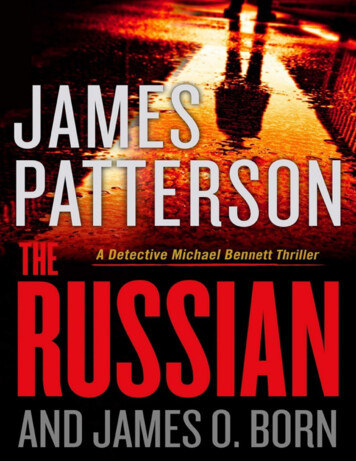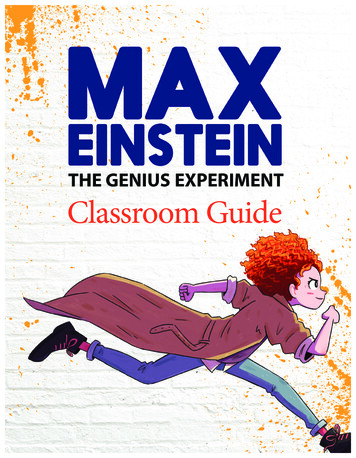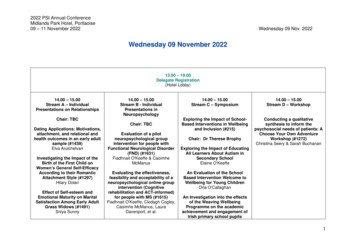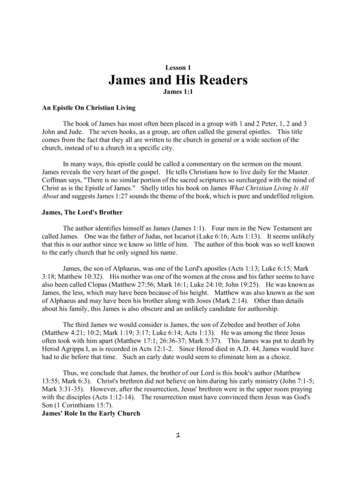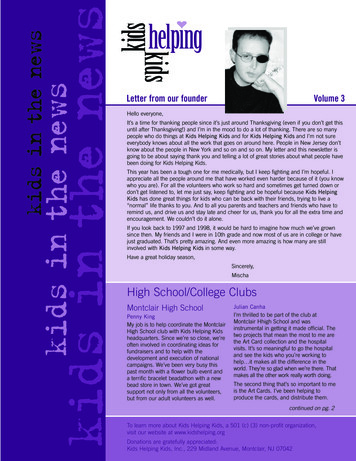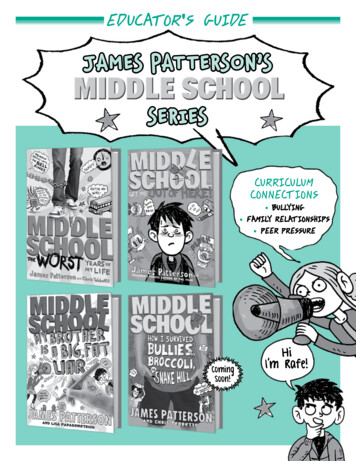
Transcription
ABOUTJAMES PATTERSONJames Patterson was born in 1947 and raised in Newburgh, New York. He studied English atVanderbilt University, and found work as a junior copywriter at the advertising agency, J WalterThompson Co, where he devised the iconic slogan, “I’m a Toys ‘R’ Us Kid.” While he became CEOand chairman of the company’s North American division in ’88 and ’90, James also pursued acareer in novel writing. He found critical success with his ’76 book, The Thomas Berryman Number,but it wasn’t until ’93 when he released Along Came a Spider that James met explosive commercialsuccess. Today, he is the world’s best selling author and holds the distinction of writing more #1New York Times Best Sellers than any other writer in history. James has sold more than 300 millionbooks worldwide and is characterized by unadorned prose, thrilling fast-paced plots, and bitesized chapters.JAMES PAT TERSON2
1.INTRODUCTIONTHINGS YOUMIGHT NEEDC L A S S WO R K B O O KJames’ Workbooksupplements each lesson withTake It Further opportunitiesand Assignments. Thisprintable PDF is filled withplaces for you to take notes asyou go.LESSON DISCUSSIONSShare your works in progressand ask your peers for help andsupport if you’ve hit aroadblock.O FFI C E H O U R SSubmit your questions on theMasterClass site and keep youreyes peeled for James’personal responses.HONEYMOON OUTLINEJames’ provides this outline forreference, which you can use tofollow along with his examples.HOW TO USE JAMES’ MASTERCLASSWelcome to James Patterson’s MasterClass! James wants to show you the mechanics and techniqueshe’s mastered to help you write your next novel. The exercises in this workbook are designed tofoster strong creative thinking skills that will help you create a complete story — from raw idea toending. Use James’ workbook to follow along with the video lessons, and share your assignmentswith the MasterClass online community to put his teachings and experiences into practice.JAMES PAT TERSON3
1.NOTESJAMES PAT TERSON4
2.PASSION HABITTAK E IT FURTHER“Do NOT sit there like ‘OhI don’t feel like it today. Idon’t feel like it tomorrow’.Feel like it! Do it! Forceyourself.”—James PattersonSU B C H A PTER S Keep the Passion Alive Love What You Do Believe in Yourself Endure Rejection Get your friends to support your new project. Post yourintentions on social media and update your status regularlyover the course of the class. Identify a few interested friendswho would be willing to provide feedback. Share your statuswith @MasterClass on Twitter and Facebook.A S SIG NMENT James became a great writer by making time everyday beforework to simply sit down and write. He encourages an hourevery day, but you can also start with a word-count goal. Trywriting just 500 words a day, work up to 1000, and then starttiming yourself! Fill in the Weekly Writing Calendar on thenext page with a schedule that works for you (eg. Monday5-6am 500 words). Focus and commit yourself to this newproject.JAMES PAT TERSON5
2.PASSION HABITWEEK LY WRITING aySundayJAMES PAT TERSON6
2.NOTESJAMES PAT TERSON7
3.RAW IDEASTAK E IT FURTHER“The more you know about,the more likely you are tocombine things to make anidea that’s striking.”—James Patterson James mentions a favorite book about ideas from hisadvertising days at J. Walter Thompson: The Act of Creation byArthur Koestler. Having trouble coming up with clever book ideas? Jamesreferences Arthur Koestler’s theory that coming up with afresh idea out of nowhere is very rare. More often what we dois put together disparate ideas that nobody has puttogether before. Here are a few tools to help get yourcreativity flowing:SU B C H A PTER S Examples of Raw Ideas Where Great Ideas Come From Try a Different Approach Write Your Ideas Down But Is It a Book? Inspiration Finder is a random generator whichprompts you to go out of your comfort zone and findsomething unusual. What-if-inator is an idea generator for possiblehistorical outcomes. Eg. “What if Einstein lived at thesame time as Napoleon?”Having a dedicated place for your working ideas is crucial forcollating and finding themes or plot lines to beginresearching. Create a place to store your best ideas, like a crispnotebook, a Microsoft Word or Google Doc, or a 3x5 card file.James uses a simple file folder.JAMES PAT TERSON8
3.RAW IDEASA S SIG NMENTS Write down three raw book ideas. They can be ideas you’vebeen toying with for awhile, or ones inspired by this class.Store them in your dedicated spot for novel ideas. You’ll beworking with them more in the next lesson. Below are six raw ideas from students who have taken thisclass. Watch James critique these ideas in his Office Hoursvideo: CRITIQUE — RAW IDEAS ASSIGNMENT. Sample 1 By Nancy V.An old man on death row for a murder he did notcommit finally accepts his fate, after 40 years ofappeals. Knowing he will be put to death the next day,he recounts the events of the fateful day that put himin prison as a young man. Sample 2 By Allegra H.A young photographer seeks a fresh start inPanama. Breezy afternoons give way to a fight for herlife, however, when she takes the wrong photo at thewrong time, embroiling her in a web of corruption, sex,and scandal. Sample 3 By Eric A.A U.S. Army communications technician returns toWisconsin after being dishonorably discharged. Hefinds work at a local paper mill to support him and hisshortwave radio hobby. While listening late one night,he picks up a transmission from a former Sovietnumbers station — a military espionage broadcastingtool that has not been active since the Cold War. Sample 4 By Malia N.Revenge is the deepest form of insanity, whether it isnoticed or not. Unnamed female character; abused byher lover Dillon, now lives at her Grandma’s house.Grandma is actually dead, and the unnamed femalecharacter — mentally ill narrates her story where sherelives terrorizing thoughts and memories in her mindfrom her basement where she murdered Dillon withscissors.JAMES PAT TERSON9
3.RAW IDEASA S SIG NMENTS (CONT ’ D) Sample 5 By Alex M.Divorced Park Ranger stationed at the Grand Canyonbefriends and accidentally kills a writer-in-residencestaying at a cabin on the north rim of the canyon. Hethrows the writer into the canyon to make it look like asuicide and then sets out on the road with hisadolescent son for their first, and final, vacationtogether, as the police unravel what happened on thenight of the murder. Sample 6 By Jonathan V.A professor of Egyptology, Dr. Amanda Walter,discovers pristine papyrus scripts of hieratic writingsfrom 13th-century BCE Egypt that include sevenmysterious mathematical equations. With the aid of anAssistant Research Professor of MathematicalCryptography, Prof. Neema Gowon, and later, an experton high-energy physics, Harold Grün, the equationsare shown to be solutions, or correct calculations, tothe problem of calculating “dimensionless physicalconstants.” The results of this discovery, which commenters dub “The Anubis Solutions,” lead to a boom ofresearch, surreal technology, terrorism, and,ultimately, a transformation of the earth into an“oceanic chaos of smartdust.”JAMES PAT TERSON10
3.NOTESJAMES PAT TERSON11
4.PLOTTAK E IT FURTHER“Don’t set out to write agood thriller. Set out towrite a #1 thriller.”—James Patterson SU B C H A PTER SA S SIG NMENTS Condense Your Plot Raise the Stakes Create Conflict Create Worthy Opponents Build in Surprises Less Is More James explains the difference between a plot and a story byusing an E.M. Forster quote: “The king died and then thequeen died, is a story. The king died and then the queen diedof grief is a plot.” Read more from Forester’s guide to writing,Aspects of the Novel.The best plots are simply told. Using your favorite raw ideafrom the lesson 03 assignment, write a plot down in 3-5concise sentences. James explains “These are not things youwrite overnight.it’s really hard to come up with a good idea.”Don’t worry if you don’t finish this assignment before movingon to the next lesson. You can always come back to it. Successful plots make readers say “Tell me more!” Jamesrecommends tapping your most honest friends for theirfeedback on your plot ideas. Once you have your original plotcondensed, call a friend and share the pitch. Pause for amoment and see if they ask for more. If they do, you might beonto something.JAMES PAT TERSON12
4.NOTESJAMES PAT TERSON13
5.RESEARCHTAK E IT FURTHER“Research really helps yourconfidence.”—James Patterson Here’s an example from James’s book Invisible that illustrateshow his research on house fires helped enhance hiswriting:“I reach the landing and pause again. Closing myeyes, I can see the licking flames from my dreams— ‘angel fingers,’ the fire fighters call them — snaking across the ceiling. The boiling smoke ripples likethe surface of the ocean just moments before the second story erupts in ash-over, simultaneously ignitingevery flammable surface and turning the cozy homeinto a convection oven.” If you can’t make it to Egypt or Antarctica for your locationresearch don’t sweat it. Here are two helpful resources forgetting a lay of the land:SU B C H A PTER S Seek Inspiration Build Your Credibility Know Your Locations Conduct Interviews Know Your Vocations Don’t Be a Know-It-All No Excuses Google Street View lets you explore world landmarks,discover natural wonders, and step inside locationssuch as museums, arenas, restaurants and small businesses with 360-degree images. They’ve collectedhighlights from their comprehensive site. From Casablanca in Morocco to Koreatown inLos Angeles, if you’re looking for names of localrestaurants or places of interest near your location,The New York Times 36 Hours column is a great place tostart.JAMES PAT TERSON14
5.RESEARCHA S SIG NMENTS James stresses the importance of finding chatty interviewcandidates and asking open-ended questions. Write downa few open-ended questions and try them out on friends orfamily. Are you getting the answers you were looking for? Aretheir answers surprising you? James suggests you add questions during the interviewthat expound on the answers to your previousquestions. Be an active listener, even if it means goingoff script. Begin researching your story byidentifying and reaching out to two potentialinterviewees for character development. Looking for the perfect person to interview for yourstory? Tap your classmates in the online community! Inthe discussion section of this lesson, add yourrequest for experts in various fields of work or withtravel experience. Then search the requests yourselfand see where you might be of service. Research two locations where your story will take place.Describe this place in four or five sentences. Try your hand at writing a short description of a parkinggarage, like James did here in his book Honeymoon: “New Yorkmay be the city that never sleeps, but at four in the morningthere are definitely parts that are barely awake. One such wasthe dimly lit basement of a parking garage on the Lower EastSide. Buried five stories beneath the street, it was a picture ofstillness. A concrete cocoon. The only noise was the numbingbuzz of the fluorescent lighting overhead.” Six parking garage descriptions written by fellow MasterClassstudents are on the following page. Try your hand at editingthese descriptions. What were the best parts? What needs tobe cut? Watch James critique these descriptions in the OfficeHours video: CRITIQUE — RESEARCH ASSIGNMENTJAMES PAT TERSON15
5.RESEARCHA S SIG NMENTS (CONT ’ D) Sample 1 By Jonathan V.Galvanized steel pipes ribbed its ceiling, between veinsof frayed cable and concrete columns that crumbledunder their yokes; stray clots of those veins hung,freighted with cobweb, like chandeliers. The dim cubicspace was a lung with end-stage emphysema. Forsixty-two years it breathed Ford and Mercedes,Mercury and Saturn, Ram and Jaguar. Sample 2 By Eric A.Four stories of split concrete and missing exit signs.Potholes made parking impossible. Only weeds wereleft to patch the cracks. Sample 3 By Shawn W.Sheets of rust-stained concrete provided undergroundrefuge shelter from the city’s swelter. The blinkingfluorescent lights diffused barely enough light for carsnavigating the garage’s narrow avenues. Winding downto the lowest level, a beam of headlights were obscuredfrom surveillance cameras above. Sample 4 By Andrew C.A parking garage is an open area enclosed by cementwalls, where people can park their cars while they runerrands. Lines painted on the ground and wallsindicate parking spaces, elevators, and flow of traffc.Typically, they’re used for drug deals. Sample 5 By Malia N.Bold colors and cold tile. Macho male’s handy tools andstacks of plastic storage containers. Empty circus carsand dusty classic motor vehicles. Sample 6 By Nancy V.The gigantic, underground, concrete structure wasdamp and dimly lit. There weren’t many cars parkedand the ones that were there had seen its better days. Itreeked of piss and homelessness; ironically, right underthe red “no trespassing” sign, a homeless man had setup his home of cardboard boxes and dirty blankets.JAMES PAT TERSON16
5.NOTESJAMES PAT TERSON17
6 7.OUTLINEPARTS ONEAND TWOTAK E IT FURTHER“Don’t think about thesentences, think about thestory. Write the storydown.”—James Patterson James explains the very basic needs for every outline, andsays a common mistake writers make is not creating anoutline. He guarantees that making this a routine part of yourwriting process will make for a better and quicker bookwriting experience. Review the Honeymoon outline. Begin referencing it for thislesson and elsewhere over the course of James’ class. As you begin to create your own outline, here are a few takeaways from Honeymoon to remember:SU B C H A PTER S What Your Outline Needs Focus on the Story Begin Sketching Your Outline Add More Suspense Edit, Edit, Edit Try a Character-Focused Approach Be Thorough Outline for Honeymoon Troubleshoot Your Outline Step Back and Start Writing Notice the rapid-fire pace in James’ outline. Each chapter is a scene, and each scene pushes the story forward. Rather than focusing on snazzy sentences, Jamesfocuses on the core of the scene which propels hisreader onto the next chapter. On page 24 of theHoneymoon outline, James skips the sordid detailsand simply identifies the key actions. “The suspensedoesn’t let up. O’Hara looks around outside the cabin.Her car is gone. Then the police arrive.”JAMES PAT TERSON18
6 7.OUTLINEPARTS ONEAND TWOA S SIG NMENTS Create a rough outline for a novel based on the story youstarted researching in lesson 05. You’ll need a five to tenchapter outline to practice the skills you’ll learn during theremainder of this class. If you’re having trouble getting started, James suggeststrying a character driven approach. What happens toyour main character in every chapter? During theediting and rewriting process you can go in and addsecondary characters, subplots, and more. Stuck on making your scene perfect? Get it the nexttime around. Write TBD and move on! As James does,you’ll be writing and rewriting this outline multipletimes.Refine your outline using what you learned in lessons 06 07. In every draft, James layers on more suspense, moredrama, and more twists. When he takes it too far he’llreign it back in, but he allows himself to be as creativeas possible during the first pass.After you’ve completed your rough outline (take your time!James spends up to four months writing and editing his),share the finished product with a friend who was interestedin your original raw idea. Have them provide honest feedbackand try to incorporate a few changes based on the review.JAMES PAT TERSON19
6 7.NOTESJAMES PAT TERSON20
8.WRITERS BLOCKTAK E IT FURTHER“Do not torture yourself.That’s how people getblocked.”—James Patterson James tells us his key to warding off writer’s block is to“freight train” through the first draft. Focus on getting thestory down. If you get stuck or feel blocked, write TBD on thatchapter and move on. James sometimes has TBD written ontwo or three chapters in a row. Don’t obsess about a singlechapter or press too hard. If you’re blocked on a scene,chapter, or even a single sentence, it’s ok to move on andcome back to it later. A 2012 study showed that moderate to low music noise levelscan increase productivity, but anything over 85 decibels candecrease your creativity. If you enjoy listening to classical orother lyric-free music but find it distracting while you write,try turning it down just a touch, and see how that increasesyour productivity. After learning about James’ daily routine, take a look at howother artists and creatives spend their time:SU B C H A PTER S Freight Train Through How James Writes Stay Focused Take a Break Take It Seriously Practice, Practice, Practice The book Daily Rituals: How Artists Work by Mason Curryoutlines the habits of nearly 200 creatives. BrainPickings details the routines of 15 great writers. Wonder where some of your favorite authors write? NewYork Times Magazine published photographs anddescriptions of where seven authors choose to spendtheir workday.JAMES PAT TERSON21
8.WRITERS BLOCKA S SIG NMENTS Set a timer for 30 minutes and write down the events of yourday. When you run out of time, note what distracted you(thoughts, noises, interruptions). Research ways that youcan selectively remove those distractions from your writingroutine. For example, does your computer distract you whileyou write? You can try going completely analog, like James. Heuses a pencil and yellow legal pad to write his novels. Try the same 30 minute challenge a day later, usingtechniques you researched to remove the distractions you discovered the day before. Repeat the process until you’ve foundyour ideal writing space.JAMES PAT TERSON22
8.NOTESJAMES PAT TERSON23
9.CREATINGCHARACTERSTAK E IT FURTHER“You want your readers tohave strong feelings aboutyour characters.”—James Patterson SU B C H A PTER S Who is Your Character? What Makes Your Character Tick? Make a Complex Hero Make a Complex Villain Make ImportantSecondary Characters Think about your favorite fictional characters, heroes, andvillains. (Need a refresher? Book Magazine lists the 100 BestCharacters in Fiction Since 1900). Make a list of your top fivefavorite characters and define five character traits for each.For example: Humbert Humbert (Lolita) — Distinguished,self-loathing, lustful, predatory, desperate Harry Potter (Harry Potter Series) — Orphan, modest,loyal to the end, brave, irritable Hannibal Lecter (Silence Of The Lambs) — Monstrous,brilliant forensic psychiatrist, serial killer, refinedgentleman, lack of conscience Willy Wonka (Charlie And The Chocolate Factory) —Dreamer Mischievous, mad scientist, eccentric,benevolent Jo March (Little Women) — Independent, tomboy-ish,blunt, opinionated, passionateCreate Reader Intimacy With your list of characters and their attributes, choose yourfavorite trait in each. Are there any similarities between thecharacters? Write a few sentences explaining what traits makeeach protagonist/villain so memorable.A S SIG NMENTS James explains: “With respect to characters, you want thingsthat really dig deep and say a lot very very quickly, to get usinterested in the person.” With that in mind, write a list of 20traits for a new character, then discard 17 traits. Do theremaining traits still make for a compelling character? On the next page are five lists received from students whohave taken this class. Watch James critique these lists in theOffice Hours video: CRITIQUE — CHARACTER ASSIGNMENTJAMES PAT TERSON24
9.CREATINGCHARACTERSA S SIG NMENTS (CONT ’ D)Allegra H.1. Tattooed2. Taciturn3. Female4. CIA reject5. Athletic6. Arrogant7. Cowboy boot wearing8. Well educated9. Brusque10. Independent11. Stubborn12. Lonely13. Lost14. Superstitious15. Hotheaded16. Transient17. Intrepid18. Alcoholic19. Determined20. TexanEric A .1. Failed stint in U.S. Army –communications technician2. Shortwave radio enthusiast3. Shops at IGA specicallyduring weekdays to avoidcrowds4. Wausau, WI native5. Green Bay Packers fan6. Raised Lutheran, leftchurch at 177. Formerly engaged, nowsingle8. Unable to pursue collegedegree due to nancial problems9. Employed at local paper millto make ends meet10. Collects cassette tapes andvinyl records11. Nearsighted12. Lactose intolerant13. Both parents deceased14. Only child15. Played cello in high schoolorchestra16. Lives in small mobile home17. Adept at shooting, despiteeyesight18. Cannot swim19. Nearly flunked out ofGerman classAlex M.1. Unemployed Tour Guidein Sedona2. Daughter of famed localMystic3. Reluctant Mind Reader4. Epileptic5. NRA Member6. Corruptible Paci st7. Conspiracy Theorist8. Envious9. Eidetic10. Polemical Graffiti Artist11. Volatile Teetotaler12. Exercise Addict13. Former Under 18 KnifeThrowing NationalChampion14. Happily widowed15. Barren16. Underappreciated17. Homeless18. Superficially Surly19. Demanding20. Self-destructive20. Does not own a televisionJAMES PAT TERSON25
9.CREATINGCHARACTERSA S SIG NMENTS (CONT ’ D)Alex M.1. To help her concentration while working on a difficultproblem, she listens to Philip Glass’s Eg y ptian-themedopera, Ak hnaten.2. She became interested in Eg y ptolog y after a dream sheexperienced in which she found herself “pleasantly confined in a dim, glittering tomb that smelled of my rrh andseashore.”3. Her “existential motto” is a quote from E.M. Forster, “Weare evolving, in ways that Science cannot measure, toends that theolog y dares not contemplate.”4. She refuses to eat dair y products and usually adds to thisrefusal a lecture on the dair y industr y.5. Si x days out of seven, she wears vibrant Hawaiiant-shirts.6. She lost her father, Benjamin D. Walter, in the last yearof the Vietnam War.7. She is the only child.8. Ever y day, she wakes up at 6:20am — her “special dawn.”And ever y night, she goes to bed at 10:20pm — her “special dusk.” This is her strict sleeping schedule.9. Her favorite book is Childhood’s End by Arthur C. Clarke.10. She considers herself “shorter than average,” at 5 feetand 3 inches.Nancy V.1. Young2. Female3. Beautiful4. Smart5. Intelligent6. Arrogant7. Strong-willed8. Driven9. Poor10. Impulsive11. Strong12. Chinese13. Courageous14. Kind15. Elegant16. Petite17. Loyal18. Lost19. Outgoing20. Stubborn11. Her only child, her son Geb Walter, died by drowning inthe California Aqueduct.12. She hates the taste of wine.13. She was adopted by a German couple in 1972.14. She has a furtive and guilt y fascination with doomsdayprophecies.15. When she was t welve years old, she found a dead cat onher walk home from school. Over a period of weeks, shewould walk by the cat and notice its stages of decomposition. The dr y and dust y environment semi-mummifiedthe cat.16. Her hair is curly and black—like her mother’s hair17. She is single, and “not looking.”18. The only time that she was happy, she believes, was inOctober of 1987, when she got lost for t wo days in thedeserts of the Sinai Peninsula. She thinks it is slightlyunsettling that she felt happy under those extreme conditions.19. Her hands remind her of t wo jelly fish.20. She tried yoga for t wo weeks, then quit “on account of myself-awareness.”JAMES PAT TERSON26
9.NOTESJAMES PAT TERSON27
10.FIRST LINESTAK E IT FURTHER“I need to feel as involvedas I want the reader tofeel.”—James Patterson SU B C H A PTER SHere are some of James’s favorite first lines from his novels: “To the best of my understandably shaky recollection,the first time I died it went something like this.” —Private “I have some really bad secrets to share with someoneand it might as well be you — a stranger, a reader ofbooks, but most of all, a person who can’t hurt me.” —Confessions of a Murder Suspect “It’s way too early in the morning for dead people.” —You’ve Been Warned Favorite First Lines Keep Pulling the Reader In Get Your Reader Invested Involve the Reader Quickly “I know things I don’t want to know.” — Swimsuit Don’t Be Afraid to Rewrite “Early on the morning of December 21, 1992, I was thepicture of contentment on the sun porch of our houseon 5th street in Washington, D.C. The small, narrowroom was cluttered with mildewing winter coats, workbooks, and wounded children’s toys. I couldn’t havecared less. This was home.” —Along Came A Spider “Let’s see what she has in her medicine cabinet. Imean, as long as I’m here.”— MistressA S SIG NMENTS Write five first lines for the first chapter of your novel. On the next page are first lines we’ve received from fourstudents who have taken this class. Based on the JamesPatterson criteria, which lines hit the mark and which needmore work? Watch James critique these first lines in the OffceHours video: CRITIQUE — FIRST LINES ASSIGNMENTJAMES PAT TERSON28
10.VOICEOVERACTINGA S SIG NMENTS (cont .) Sample 1 By Jonathan V. It was a heavy weakness that morning. “Is that pleasure tape?” Larry’s foot puffed into a purple, glossy,pineapple-shaped mess. Her funeral was attended only by one. Why is the sun blue? Sample 2 By Andrew C. I wouldn’t say it was an earthquake. Danny could throw a ball farther than anyone inthe fourth grade, and twice as far anyone in thethird What could I do? When I walked into the kitchen my grandfatherwaswearing a petite skirt and drinking schnappsfrom his favorite coffee mug. Cool early morning air wafted up, as Brandt lit hiscigarette and studied green nine. Sample 3 By Eric A. I never expected to hear anything, but there wassomething alluring about the void. The last stations should have died with Yeltsin — operatorslistening then heard monotone Russian broadcasts fading into the dull thrum of radio silence.I slipped on some headphones to try to filter outthe noise. The voice surged and broke through theveil of static. It was screaming. Sample 4 By Nancy V. It started out as any other school day. Blair wasrunning late, but Nate wouldn’t get out of thebathroom. She was never sure if he was doing itjust to annoy her or if he’d really needed to bein the bathroom. She shouts, “Nate, if you don’topen the door this second, I am going to strangle you, then tell Mom I strangled you,” as shepounds on the bathroom door. Nate opens thedoor with a smirk on his face, “Geez, someonewoke up on the wrong side of the bed.”JAMES PAT TERSON29
10.NOTESJAMES PAT TERSON30
11.WRITINGDIALOGUETAK E IT FURTHER“Everything you writeshould be moving yourstory forward.”—James Patterson Heightening real dialogue ensures you won’t bore the readerwith chitchat they can hear anywhere. Here are a few tips tohelp you avoid ordinary dialogue: Pay attention to how people interact the next timeyou’re on the subway, in a cafe, or at a restaurant. Whatabout their conversation was interesting? What partsbored you? The next time you watch a favorite TV show or movie,turn on the closed-captioning and mute the volume.Read the dialogue between characters. Does it read aswell as it does when you’re listening to it? Find the script of a popular film and read the dialoguewithout watching the movie. Does the scene resonatewith you without the visual storytelling?SU B C H A PTER S Example of Great Dialogue Heighten Reality Reveal Your CharactersThrough Dialogue Do Exposition the Right Way Compress Time Move the Story ForwardA S SIG NMENTS Write dialogue (using no narration) between two charactersusing this prompt: A man comes home from work early and his wifeintercepts him in the living room. He doesn’t want totell her that he’s just been fired; she doesn’t want himto know her lover is in the bedroom.In the following pages, four MasterClass students show whatthey came up with using the above exercise. Use what you’velearned in this lesson and try your hand at editing thisdialogue. Listen to James critique these scenes in the OfficeHours video titled: CRITIQUE — DIALOGUE ASSIGNMENTJAMES PAT TERSON31
11.WRITINGDIALOGUEA S SIG NMENTS (cont .) Sample 1 By Sean C.“You’re sweating.”“Oh — I took a hot shower,” she said, retying theknot in the belt of her robe.“It’s ninety degrees outside.”“My sinuses have been bothering me. I thought thesteam would help.”“I need a drink,” he said.“Bad day at work?”“You could say that.”He turned towards the kitchen.“You want to drink here? Why don’t we go out?” Shesaid.“No—”“Are you okay? What happened?”“I’m fine. It’s just offce politics.”“I can see it in your face. Why don’t we go to Twigs?Get a nice dinner, a few drinks. You don’t really wantto sit here drinking beer, watching Sports Center doyou?”She placed her hands on his chest, eyes looking upinto his.“I’m not in the mood to go out in public,” he said.“We could go pick up a pizza.”“I don’t want to pay for a pizza. Why don’t we justhave some wine and the rest of your lasagna? I wantto get drunk and spend the night in bed,” he said,reaching under her robe.”JAMES PAT TERSON32
11.WRITINGDIALOGUEA S SIG NMENTS (cont .) Sample 2 By Allegra H.“William? Is that you? Christ, you scared me halfto death.”“When did my wife become so easily rattled?”“Well you know there’ve been all those burglarieslately, and what are you doing home so early anyway?”“Headache. Think I’ll go lie down.”“Oh sweetie, would the couch do? I was reorganizing the closet and my shoes are spread out all overthe bed.”“I’ll push them aside.”“It’s really a mess in there — I’d rather you notsee.”“Don’t tell me you’ve been shopping again.”“When did my husband become such a Grinch?”“It’s the headache.”“You poor thing.always working so hard.”“I think I’m going to take that nap now.”“Wait! Let me make you some lunch first.”“I’m not — what was that noise?”“What noise?”“In the bedroom. I heard—”“A burglar!”JAMES PAT TERSON33
11.WRITINGDIALOGUEA S SIG NMENTS (cont .) Sample 3 By Jonathan V.“You’re early.”“You’re observant. I wasn’t feeling well.”“My poor s
James Patterson was born in 1947 and raised in Newburgh, New York. He studied English at . James has sold more than 300 million books worldwide and is characterized by unadorned prose, thrilling fast-paced plots, and bite-sized chapters. JAMES PATTERSON ABOUT JAMES PATTERSON.
